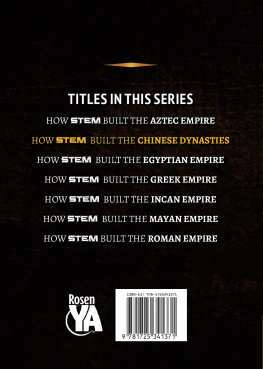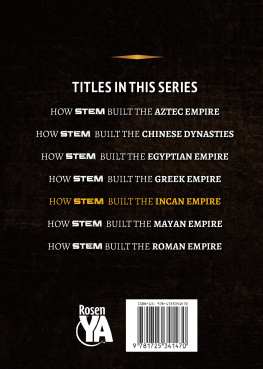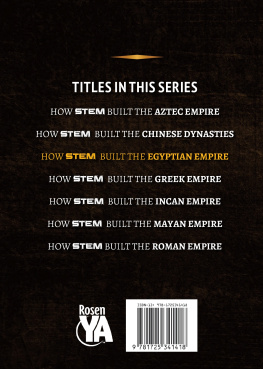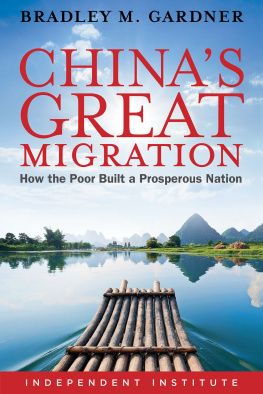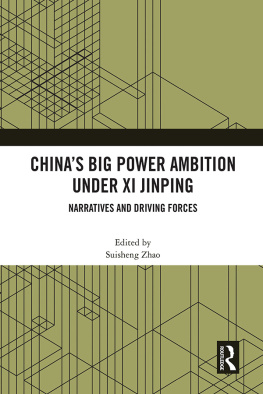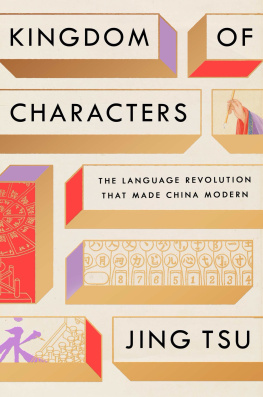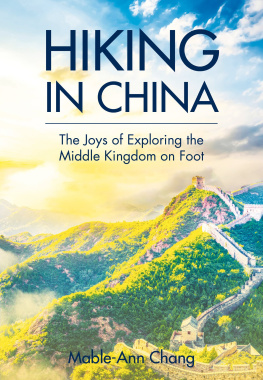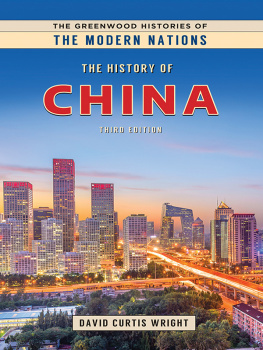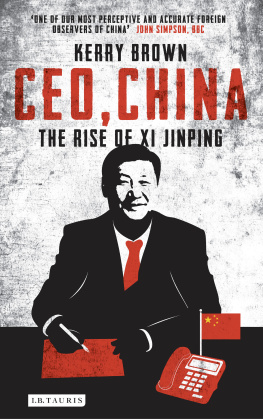
Published in 2020 by The Rosen Publishing Group, Inc.
29 East 21st Street, New York, NY 10010
Copyright 2020 by The Rosen Publishing Group, Inc.
First Edition
All rights reserved. No part of this book may be reproduced in any form without permission in writing from the publisher, except by a reviewer.
Library of Congress Cataloging-in-Publication Data
Names: Hessel-Mial, Michael, author.
Title: How STEM built the Chinese dynasties / Michael Hessel-Mial.
Description: First edition. | New York: Rosen Publishing, 2020. | Series: How STEM built empires | Audience: Grades: 7 to 12. | Includes bibliographical references and index. Identifiers: LCCN 2019008455| ISBN 9781725341388 (library bound) | ISBN 9781725341371 (pbk.)
Subjects: LCSH: ScienceChinaHistoryJuvenile literature. | TechnologyChinaHistoryJuvenile literature. | EngineeringChinaHistoryJuvenile literature. | MathematicsChinaHistoryJuvenile literature. | China CivilizationJuvenile literature.
Classification: LCC Q127.C5 H597 2020 | DDC 303.48/30951dc23
LC record available at https://lccn.loc.gov/2019008455
Manufactured in the United States of America
On the cover: The Great Wall of China was built on a foundation of other incredible Chinese STEM knowledge.
CONTENTS
INTRODUCTION
I n the early 1900s, China was stagnating. Empires like Japan and England had taken control of parts of the country after several humiliating wars, and countless peasants were on the brink of starvation. Many observers complained that the Chinese were too tied to their traditions to advance in the modern world. Some argued that people needed to stop following the old waysand start embracing modern scientific ideasto develop the country. People listened. Today, China is one of the fastest-growing economies in the world and is entering the realm of world superpower.
Is this recent rise a new development? Is China late to the game, only becoming successful after abandoning its past? Not quite. In fact, the Central Kingdom (the official name of Imperial China) was perhaps the most enduring power in world history. When Italian merchant Marco Polo visited China in the late thirteenth century, he was stunned by what he saw: innovations such as paper money and the use of coal as fuel, unheard of in Europe at the time, were commonplace in China. For centuries after, China was admired by the rest of the world for its million-person cities, vast naval power, and stunning inventions. Indeed, Chinas four great inventions (gunpowder, paper, printing, and the compass) alone would change the course of science, technology, engineering, and math (STEM).

Shown here is a coin from the Sui dynasty, one of the earliest standardized coins in existence. A long-standing theme of Chinese STEM and governance was the use of common standards to unify the country.
The story of Imperial China is a gripping drama of competing states and dynasties, with periods of flourishing culture alternating with sudden shifts in power. Traditional Chinese historians believed in the Mandate of Heaven, which declared that the right to rule China was chosen by cosmic destinya concept with major political, religious, and scientific consequences.
Chinese STEM, like that of other empires, was shaped by values and beliefs specific to China. Astronomy stemmed from a desire to predict the dynastys future, which eventually paved the way for advancements in mechanical engineering and mathematics. Religious beliefs in the mystical laws of nature led to explorations of chemical properties and the workings of the human body. Understanding these cultural values is vital to understanding the STEM they eventually shaped.
It is common to think of the history of STEM as a succession of great names, moving in a direct line from Archimedes to Isaac Newton to Albert Einstein. China itself offers many talented figures who contributed to STEM, but these thinkers, scientists, and inventors are just part of the story. Many of Chinas inventions evolved over long time periods, spread by diffusion, and were anonymously perfected over time.
As Chinas fortunes rose and fell through the centuries, geniuses in science, politics, and warfare would toil alongside unknown inventors and workers solving problems. People would debate the most virtuous way to run a state or simply seize it outright. People discussed the citizens role in the country, Chinas place in the world, and the natural worlds place in the cosmos. Each of these questions spurred people to discover and innovate with STEMand, in the process, shape Chinas destiny.
CHAPTER ONE

EARLY CHINESE CULTURE AND THE STRUGGLE FOR UNIFICATION
T he earliest Chinese civilizations were established near the Yellow River, which cuts through the middle of modern-day China. In ancient times, being close to water meant controlling the agriculture that depended on it. These civilizations built their earliest structures from rammed earth, an early form of brickmaking that compressed a combination of soil and gravel to make floors and walls. Prehistoric Chinese people lived similarly to their neighbors in Central Asia: they grew millet and rice, raised domesticated animals, and used stone tools. They used cowrie shells as currency and made pottery without the use of a potters wheel.
Prehistoric Chinese inventors, forgotten to time, drew on the natural world for inspiration. There are ancient archaeological remains of drinking vessels with traces of wine, suggesting that the Chinese discovered fermentation. China also invented sericulture: the use of silkworms to produce silk. Early sericulturists grew silkworms, which would build their cocoons in mulberry bushes. Craftswomen would then boil the cocoons, untangle the fine silk threads, and weave shimmering fabric.
CHINESE DYNASTIES FORGE THEIR IDENTITY FROM MYTH AND BRONZE
According to traditional Chinese histories, the three first dynasties are the Xia (2100-1600 BCE), the Shang (1600-1050 BCE), and the Zhou (1046-256 BCE). Today, the Xia is understood as mythologicala fictional example made up by later scholars as a moral foundation for future dynasties. However, even the Xia myths contain important lessons about STEM in ancient China. Huangdi, the godlike yellow emperor, was considered the father of agriculture and the inventor of Chinas first tools and weapons. Huangdis wife, Leizu, was said to have invented silk weaving. Another legendary emperor, Yu the Great, was said to have tamed the waters of the flooding Yellow River by digging drainage canals.
The Shang dynasty is the first Chinese empire supported by objective historical evidence. This dynasty was a Bronze Age civilization, meaning that craftsmen learned to work with bronze to make tools, weapons, and ceremonial objects. At this time as well, people added wheat to their traditional diet of millet and rice. The standout feature of the Shang dynasty is the emperors use of oracle bones to predict the future. These bones are the earliest source of Chinese writing in existence.
Around 1046 BCE, the Shang dynasty was overtaken by the Zhou dynasty. The Zhou created a more organized society; they governed from walled cities and established a land-distribution program called the well-field system. This system decreed that one-ninth of all private lands were the property of the Zhou, and the products of those lands would be reserved for taxes and redistribution. The Zhou expanded the making of bronze by conscripting forced laborers and experimented with early ironwork.
Next page
